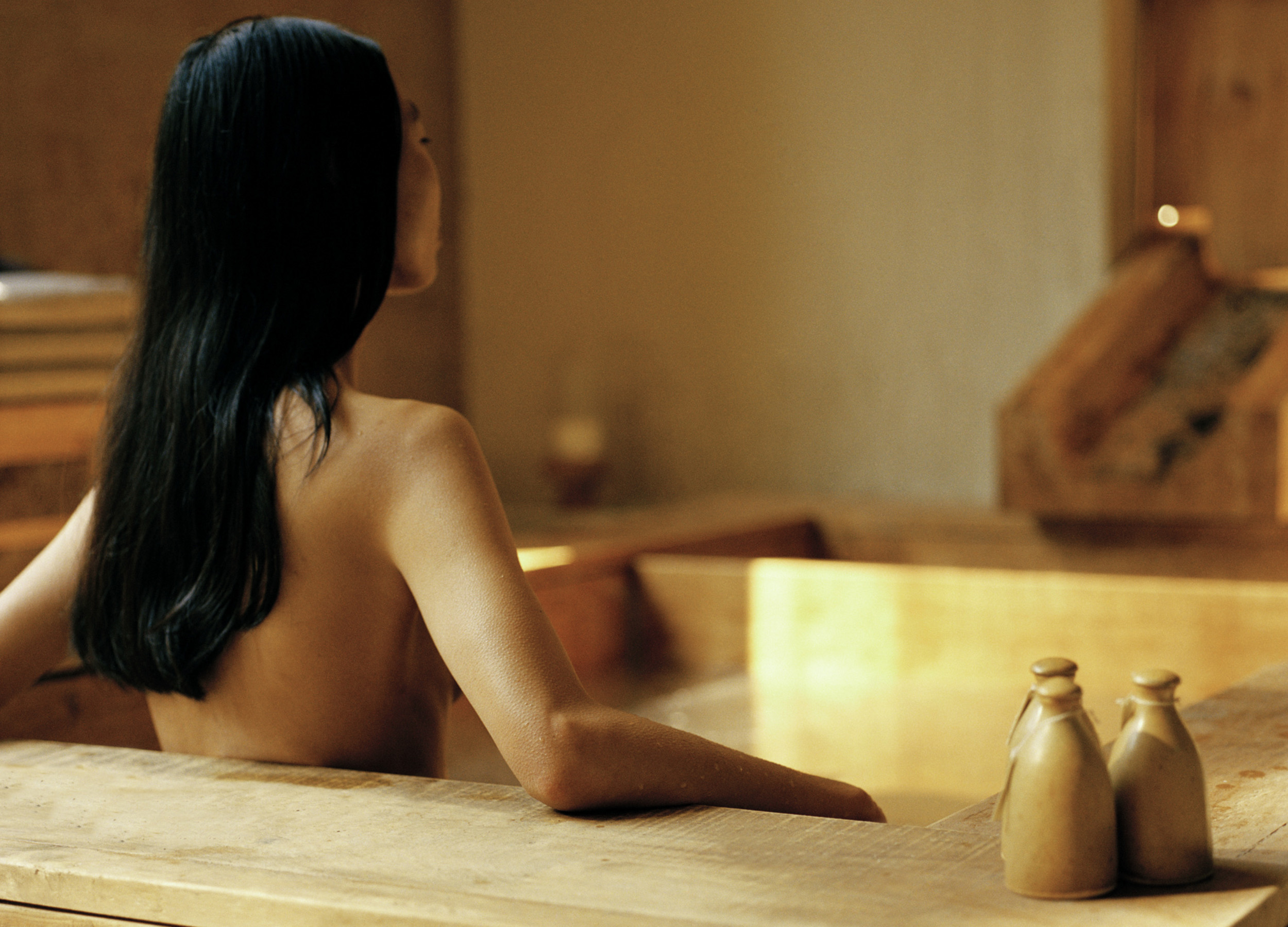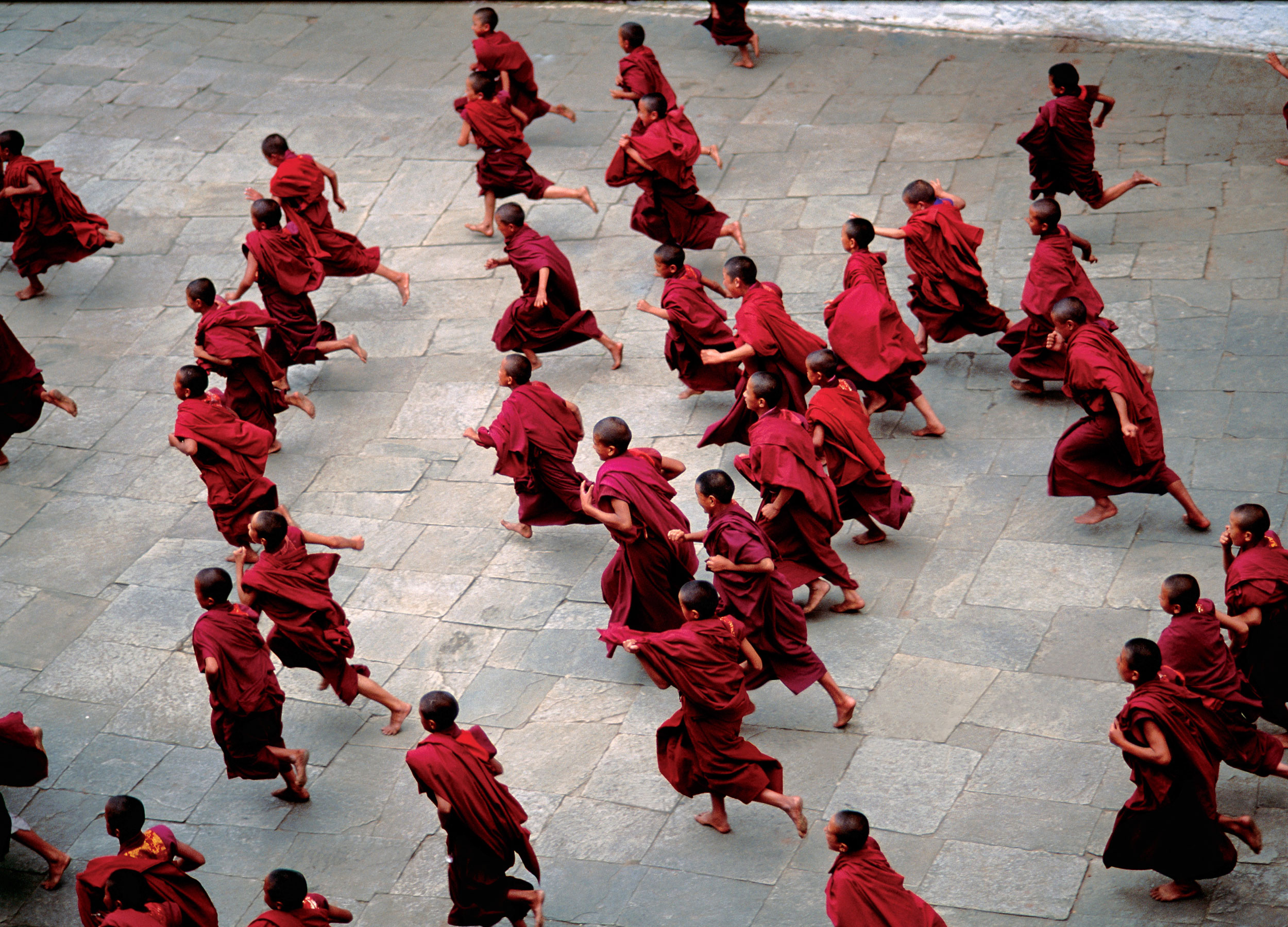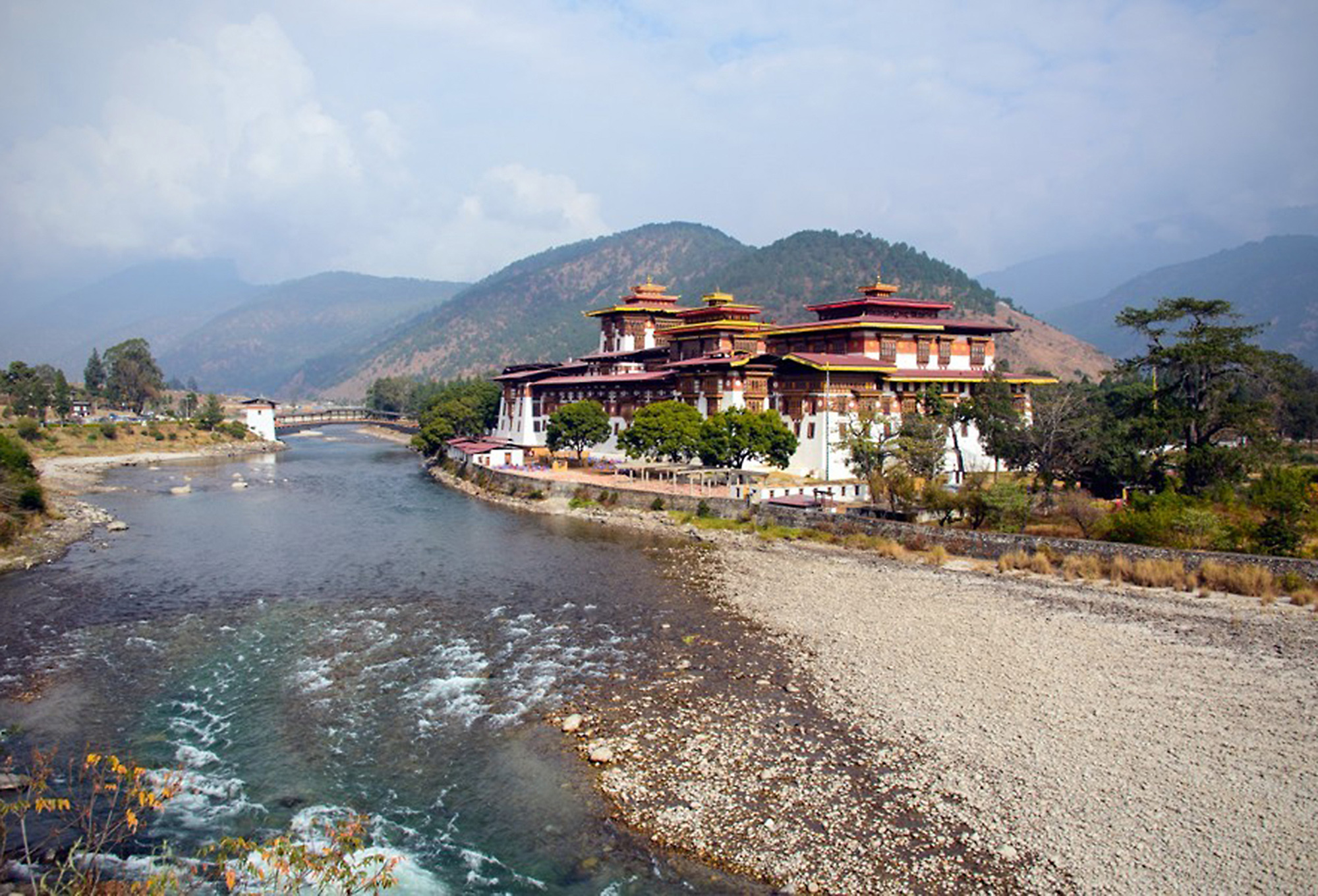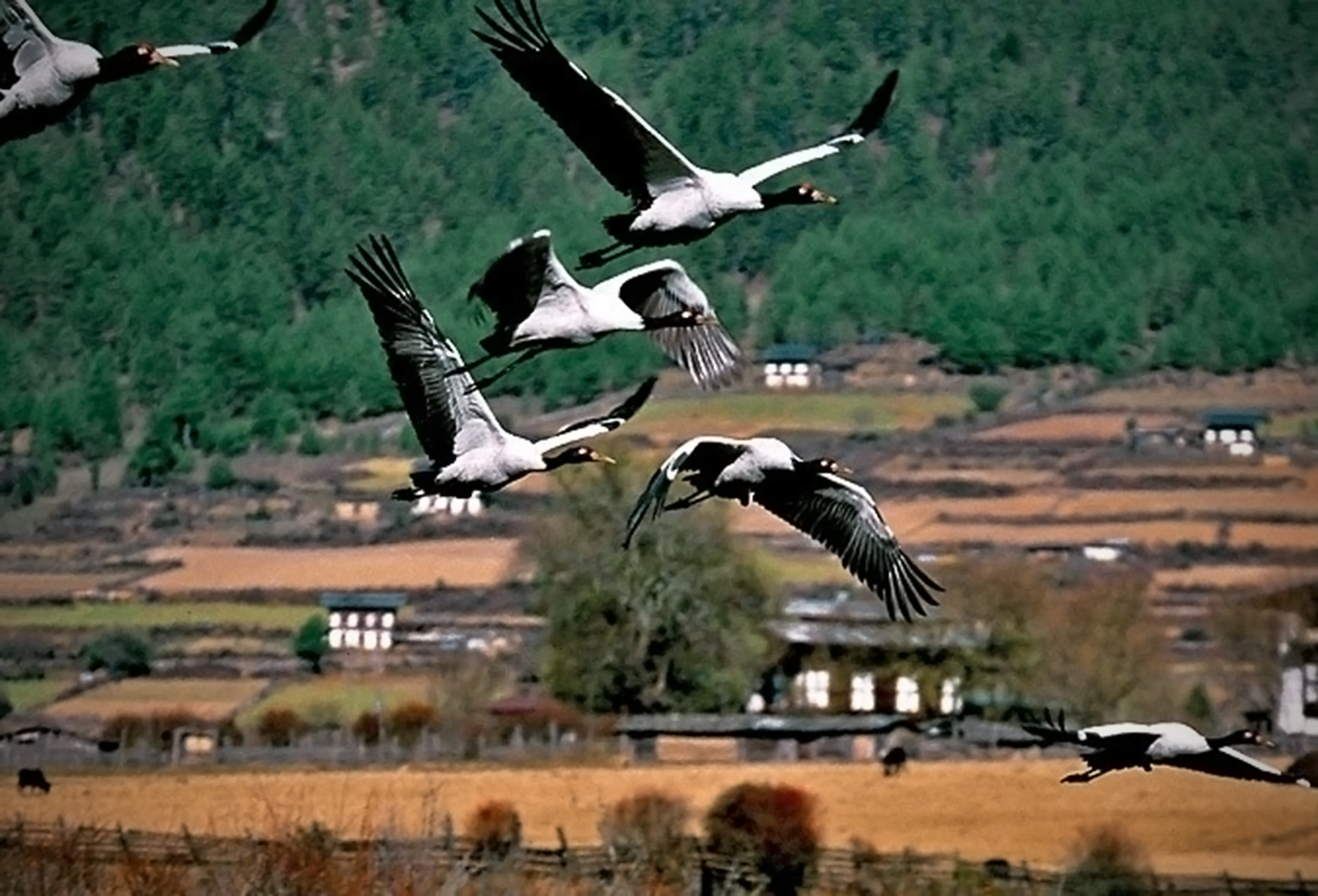There waiting for me is a wooden shed with flung-open-wide barn doors and, within, a sturdy timber tub. The water it contains, topped by fragrant green foliage, is tepid — though not for long.
To the left of the shed is a fire in a pit, stoked energetically by a gnarled old villager. From the looks of it, he could be roasting meat — but the set of large steel forceps he is wielding isn’t clutching dinner. From out of the glowing coals he lifts one of a number of large stones that he manhandles to his end of the tub, separated from the other two thirds by a barrier of wood and wire screen. Having been invited to disrobe and immerse myself in the water, I watch with a great deal of curiosity — and just a little initial fear for my wellbeing — as he loads one heated stone after another into the tub. That the water never actually boils is a testament to his skill, and that I enjoy every moment of my stone bath experience is a testament to my trust in it.
Sitting in a towel on a log outside the hut, my fingers starting to prune from a prolonged soaking, I gaze down the mountainside as the final embers of the day’s sunlight play across the valley. I’m struck by my contentment. I could assemble a range of other adjectives, but suffice to say that I am happy, very happy. It could be said that in achieving that state, I have fulfilled a tenet of the state: one is supposed to be happy in Bhutan. It is in the constitution, or something like that, and it may be the one thing about the Dragon Kingdom — the mystical landlocked Himalayan nation near Tibet and Nepal — that most people beyond its borders do know about.

It was some 30 years ago that the fourth king declared formally that, while other nations might measure their progress and standing by GDP, his would be developed along the lines of GNH (gross national happiness). It is a revolutionary concept, to be sure, and one that has shaped business, education and government since, capturing the attention of the world as it progresses in its own holistic way. The theory behind it all is that rampant consumerism is unsustainable because it perpetuates an endless cycle of greed for more, followed by the inevitable dissatisfaction that more is never enough. Just to make sure no one misses the point, Bhutan’s official tourism slogan is ‘Happiness Is A Place’. I watch an elderly American lady being greeted by her guide at Paro Airport. “Welcome to the land of Gross National Happiness,” he beams. “That’s what worries me”, she says, smiling. “I’m not entirely sure how happy I’m supposed to be.”
Well, I play it by ear and feel I am off to a strong start when I am informed that this country of around 750,000 citizens has a traffic light count of zero. Apparently there was one in place in the capital Thimphu, but public agitation had it removed. Throw in a national obsession for red chillies, endlessly fluttering prayer flags, and the realisation that in this egalitarian land women have the same rights as men and participate actively in the nation’s affairs. Sighting a proliferation of display signs bearing such decrees as ‘This is a highway, not a runway’, ‘Inconvenience regretted’, and simply ‘Thank you’, and, well, the place has me in its palm. And while I hesitate to say that I am much taken by walls and doorways bearing erect phallus depictions, they certainly do command my attention and comment when I come upon them.

However one derives pleasure and satisfaction in travel, the Shangri La aspects of Bhutan are unquestionably plentiful. The breath is knocked out of me more than once by the sheer physical beauty of the country’s vistas, nooks and crannies. The land sweeps upwards, stage by stage, from luxuriant jungle plains just a few hundred metres above sea level down south by the Indian border, to a dozen or so snow-clad mountains (many never climbed) more than 7000 metres high near the Tibetan plateaux in the north. The motif of the country is wide, verdant and artfully cultivated valleys flanked by pine forested mountains with deep ravines, sweeping watercourses and rich flora and fauna.
With Mahayana (or Tantric) Buddhism the state religion of Bhutan — the only nation where that is so — every skyline catches a spiritual architectural imprint. While the magnificent dzongs (castle-scale religious fortresses constructed in strategic locations throughout the kingdom early in the 17th century) have an indelible impact upon the consciousness of outsiders, there is also a constant aura of peace and serenity radiated by the chortens, thousands of what the Indians would call stupas. These faith-affirming structures are found on high mountain passes, busy thoroughfares and crossroads, near monasteries, in villages and in other places often unexpected. They symbolise the universe and its combination of elements: earth, water, fire, air and the ether, what is said to be the essence of the spirit. They constantly remind us just where we are, though that is also accomplished by the gho and kira — traditional male and female garb worn universally.

If there is a sense that one is an honoured guest in Bhutan rather than a traveller, it may be because that is exactly what one would have been not that many decades ago. There was a time, before the commencement of services at Paro airport in 1983, when the only foreigners who made it in were personal invitees of the royal family. Even when the first substantial influx of visitors took place a couple of years after the coronation of the third king in 1972, it was an arduous undertaking. The few hundred allowed to enter this closed country (where they were restricted to visiting just Paro and Thimphu) either crossed over the borders by road or wrangled a seat on a pair of Drukair 16-seater twin propeller unpressurised planes that could barely navigate the cloud line. If they got in, they could be stranded by weather for days or weeks. It is still the case that landing at Paro is such a challenge that, at last count, only eight pilots in the world were certified to do so.
For 40 years, the Bhutanese operated a low volume, high cost visitor policy. They sought and received discriminating travellers who very much wanted to be there and were prepared to meet the not-inconsiderable cost of doing so. Nowadays, it is no longer a prohibitive destination. Visas are easily obtained, there are hundreds of private tour operators and a wide range of accommodation, and Bhutan is no more expensive than anywhere else in the region.
This is not to say that the top end of tourism does not thrive. Tying it up rather neatly is the Aman group, which operates five prestige properties under the banner Amankora, only one of which, interestingly, has any exterior signing. Almost all their clientele go for the ‘Aman combo’, moving about the western and central regions of the country in single vehicles with private guide and driver, staying at lodges in Paro, Thimphu, Punakha, Gangtey and, less often, the farther-flung Bumthang. With similarly-designed interiors of considerable comfort, these well-integrated lodges are tall, white-washed stone buildings, heavily timbered and low profile near-palatial complexes. The Punakha property is the exception: accessed by suspension bridge over the Mo Chhu River and a cart ride up a winding path, it is a traditional three-storey farmhouse built by a former Chief Abbot of Bhutan.

Aman Punakha proves to be the most amenable: sited in the lowest valley, it thus has temperate weather and bread basket ambience, and being at the confluence of the Mother (Mo) and Father (Pho) rivers, there is even white water rafting. It is also home of the Punakha Dzong, a visually enchanting building that some admirers rate with the Taj Mahal and some of the Angkor temples. The capital of the country until 1955, this is where kings have their coronations (and where they spend their summers and keep their horses, who may be visited), the gods and demons of Buddhist mythology are celebrated in elaborate festivals and ceremonies, and the nation’s religious elite and their vast entourage spend half a year in residence. It is approached by a famous cantilevered bridge that was washed away by a flash flood around 1957 and painstakingly rebuilt.
However, each Amankora property has its own tone and attractions. The less imposing Aman Gangtey, where I take my stone bath, is perched high on the western slopes of the Black Mountains, large glass ‘walls’ in the dining and recreation area allowing a view to a valley that plays host to seasonal flocks of endangered migrating black neck cranes. There are telescopes in place to look upon the birds, and the 16th century Gangtey Goemba Monastery on the opposite slope. If we make our way there at the right time, we may be able to arrange an audience, if he is in residence, with the highly-revered Tulku.

Seeking out holy figures and places is a favoured undertaking for visitors to Bhutan, which may explain the popularity of crisp-aired Paro, which sits at an elevation of 2250 metres. There, most mornings, abundant numbers of foreigners are off up to the Tigers’ Nest. At least two hours up and possibly as many down, it is a strenuous near-vertical walk (or horse ride, I will confess) to Taktshang Goemba. A monastery more than 300 years old, it is sited, some say miraculously, on a precarious precipice 900 metres above the floor of the Paro Valley, appearing to be more a product of Hollywood computer-generated imagery than architecture.
Legend has it that, with the right spiritual plane or connections, one can bypass feet and steed and make it up into the clouds on the back of a magic tiger — though they seem in short supply the day I make my way upward. Legend also insists that the complex of ornate religious buildings is anchored in place by the hairs of dakinis (celestial beings), which is as good an explanation as any for how everything hangs together. It clings, as one phrase goes, to the side of the mountain like a gecko.
Just as we may try to cling to Bhutan, we are inevitably separated from it. But, from roadside apple sellers, child wood carters and nattily dressed evening strollers, to wheat threshers, yak herders, and artists and scholars going about their lives, there is much to take with us as recollection, snatches spinning along with the prayer wheels.

